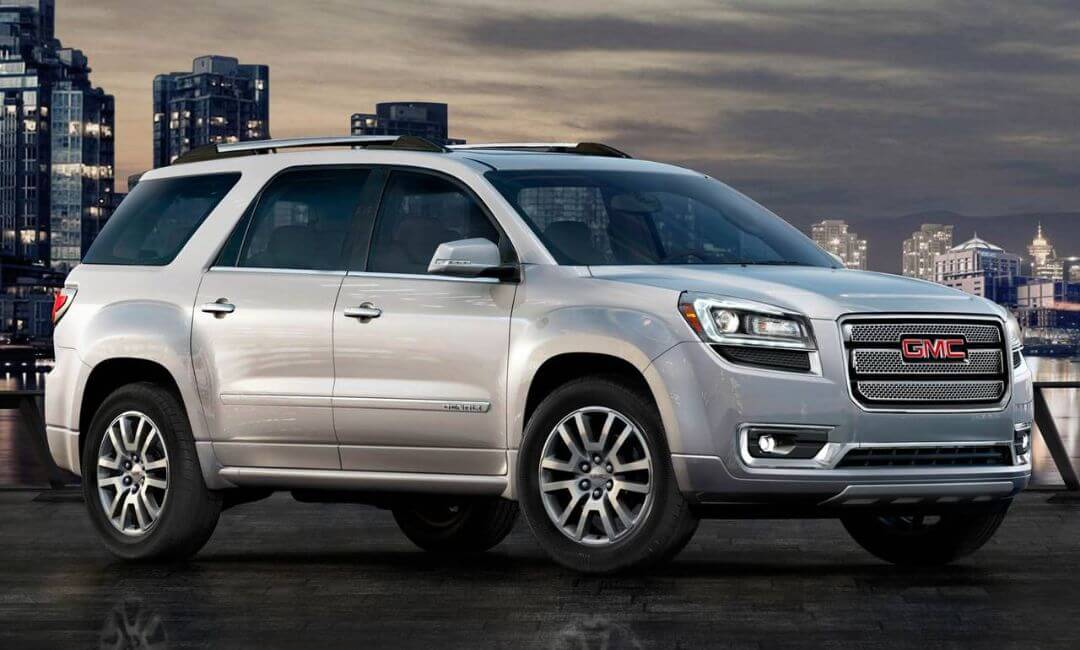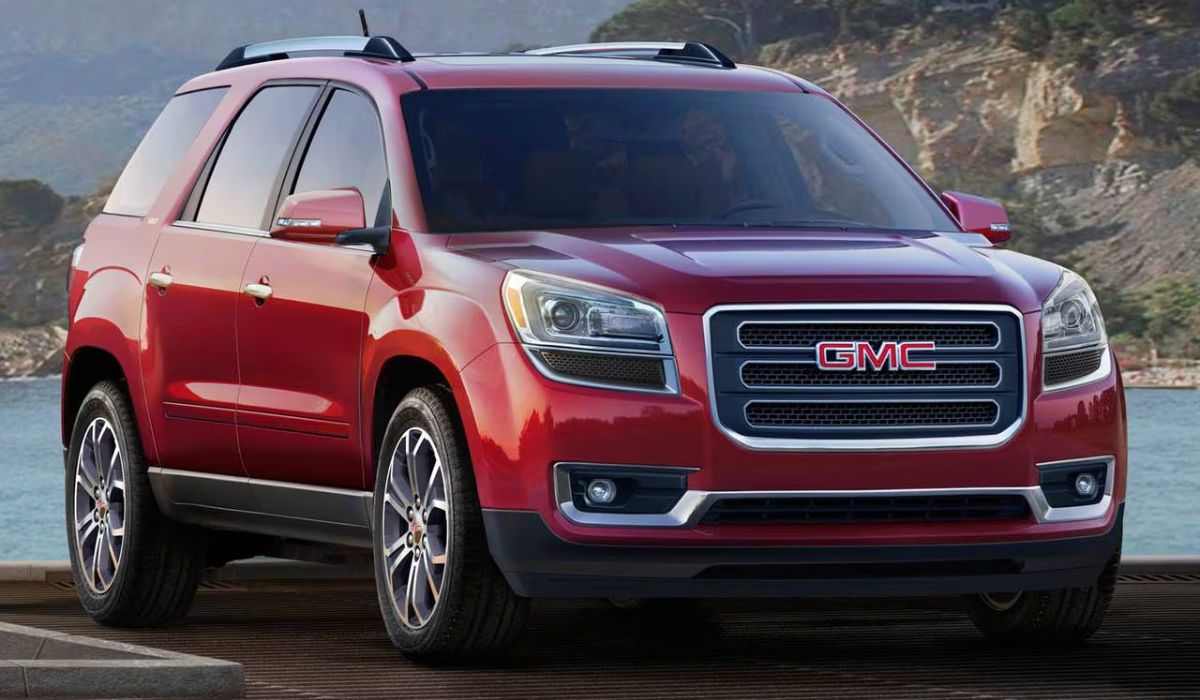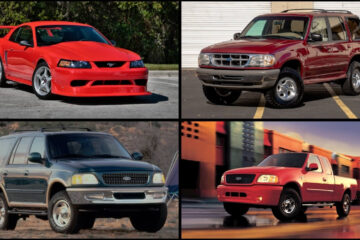If you are shopping for a large, family-friendly SUV with a hint of muscle, the GMC Acadia should look familiar. The Acadia, Designed for families seeking a midsize SUV from General Motors, offers three rows of seats, ample cargo space, and an optional all-wheel-drive system. This is why we think it can be equally at home on the weekday work route as it is on a weekend getaway.
Since its introduction in 2007, the GMC Acadia has maintained a steady following due to its smooth ride, refined cabin, and solid V6 engine. However, in proper long-term run form, it hasn’t always been a bull’s-eye.
There have been good (and bad) model years in the past in terms of performance and reliability. Between transmission failures and bad timing chains, to say nothing of the electrical and steering issues, there are multiple years of the Acadia that you should skip if you’re looking for a used SUV. GMC Acadia Years to Avoid Common Problems You Need to Know Before Investing!
In this comprehensive guide, we’ll review the worst GMC Acadia model years based on owner complaints, recall history, and expert analysis. You’ll learn about the typical issues to look out for, the used Acadias worth considering, and how to avoid one of these, along with all its costly repairs. Before you burn your savings on your next new vehicle, make sure you know which versions of this popular SUV are the most reliable—and which you should avoid like the plague.
Must Check: Toyota Tundra Years to Avoid and the Worst Problems Owners Faced
GMC Acadia Overview: A Quick Timeline
The GMC Acadia debuted in 2007 as a model and has since become a strong player in the midsize SUV segment. It was designed to provide ample room, family-friendly utility, and decent performance, and the Acadia quickly emerged as the go-to choice for buyers who wanted three-row seating without having to upgrade to a full-size SUV. Throughout its life, the model has undergone influential revisions, which impact its reliability, performance, and , consequently, the vehicle’s used market value.
The initial-generation GMC Acadia (2007–2016) was constructed on the GM Lambda platform. It was aggressive on the outside, spacious on the inside, and packed under the hood with the best of the best. However, the period was marred by a torrent of quality problems. Issues such as transmission failure, timing chain stretch, and electrical malfunctions were prevalent, particularly in the early model years. These issues have already marked some of the early first-gen models as being used for SUVs to avoid.
In 2017, the Acadia was redesigned, losing weight and size in its second generation. Later generations of this platform also featured improved fuel efficiency, advanced technology, and enhanced safety features. Because second-gen Acadia models offer more polished driving dynamics and fewer reported mechanical complaints, they’re often considered the wiser used buy, particularly from 2020 on.
It is vital not to forget that all GMC Acadia models are not created equal. Some years were well-built and dependable, while others concealed expensive mechanical and electrical problems. In the following sections, we will help you identify which GMC Acadia model years to avoid, as well as discuss the most significant issues they are prone to.
GMC Acadia Years to Avoid

Not all GMC Acadia model years are like this. And while the new editions earn high marks for new technology and reliability, specific earlier models are tarnished with a reputation for mechanical trouble that might cost you thousands to fix. The worst years of the GMC Acadia to steer clear of also include high overall owner complaints, recall data, and recurring long-term maintenance issues.
1. 2008 GMC Acadia – The Worst Offender
Key Problems:
- Transmission failure at ~75,000 miles
- Power steering pump issues
- Timing chain stretch (especially in the 3.6L V6)
Why to Avoid:
As a model year 2008 vehicle, the GMC Acadia is among the least reliable. Many owners have experienced catastrophic transmission failure long before even 100,000 miles. The transmission replacement or rebuild usually costs upwards of $ 4,000, not including labor or components. This year, we also experienced issues with the power steering pump failing, which rendered the car unable to steer and potentially led to an accident. Stretching of the timing chain was also premature and would set a check engine light, potentially leading to long-term engine damage if not addressed promptly.
2. 2007 GMC Acadia – A Risky First Year
Key Problems:
- Transmission slipping
- Sunroof leaks
- AC compressor failure
Why to Avoid:
The 2007 model was the first year in Acadia’s lineup and came with a lot of growing pains. The most common problem reported was transmission slipping, particularly in AWD versions. Drivers initially complained of erratic shifting, sluggish acceleration, and complete transmission failure. The infamous sunroof leak issue continued to cause havoc, resulting in interior water damage and electrical system failures. Failed AC compressors made the roster, with many owners requiring replacements within the first 2-4 years of ownership.
3. 2011 GMC Acadia – Electrical and Steering Woes
Key Problems:
- Random electrical malfunctions
- Power steering pump and rack failure
- Frequent check engine lights
Why to Avoid:
The 2011 Acadia struggled with severe electrical issues, as owners complained that all types of electronics, from dashboard lights to the infotainment system, would behave erratically. Steering system failure involving the pump and rack was one of the most hazardous and costly. This work frequently cost over $1,500 and, in many cases, took place out of warranty. With the ongoing electrical issues, surely this year rightfully deserves to be put on the avoid list.
4. 2012 GMC Acadia Transmission
Key Problems:
- Transmission slipping/failure
- Overheating Engine
- Premature timing chain wear
Why to Avoid:
While GM was already working to correct its troubling reliability record, the 2012 Acadia still fell short of expectations. Transmission woes were not uncommon, and many units gave out before 100,000 miles. Another common problem was engine overheating, frequently caused by a faulty water pump or thermostat. And timing chains were still failing early, causing engine codes and substantial repair bills.
5. 2013 GMC Acadia
Key Problems:
- Timing chain stretch
- Check engine light with codes P0008/P0017.
- Transmission hesitation
Why to Avoid:
The 2013 Acadia featured new exterior and interior styling. However, underneath the hood, serious mechanical issues persisted. The timing chain stretch problem, in particular, was widespread, triggering check engine lights associated with camshaft position errors. These issues would usually necessitate a complete timing chain replacement – an ordeal that could cost thousands of dollars. A few owners also reported difficulty shifting, which contributed to the model’s ranking for problematic drivetrain performance.
Read More:
- Chevy S10 Years to Avoid (And the Best Years to Own)
- Dodge Journey Years to Avoid Some Are Real Headaches
- Mazda CX5 Years to Avoid and the Worst Problems They Have
Common GMC Acadia Complaints Throughout Model Years

Some GMC Acadia years to avoid are more easily identifiable than others, but even some outside those year ranges may still cause persistent problems. Many of the early Acadia model year mechanical and electrical issues are not limited to a specific year or years—these problems affect various generations. If you’re eyeballing a used Acadia, then here are the most common problems that you’ll want to check out, even in model years that should be “safe.”
1. Transmission Failure
- Affected Years : 2007–2012
Transmission failures were among the most prevalent and expensive problems that the first Acadia models experienced. Owners report slipping gears, harsh shifting, and total transmission failure, many before reaching 100,000 miles. Repairs usually involve a complete rebuild or replacement, with a price tag of $3,500–$5,000.
2. Timing Chain Stretch
- Affected Years: 2007-2013
The 3.6L V6 engine is found in most early Acadias and is susceptible to early wear of the timing chain. A stretched chain can throw codes (P0008/P0017) and set a check engine light, resulting in a rough running engine at the start or while running, and failure to act on these symptoms may result in an engine that suddenly ceases to operate (Catastrophic failure).
3. Power Steering Failure
- Affected Years: 2007–2011
A loss of power steering, particularly in low-speed turns, has been frequently reported. This can render the SUV difficult to handle and unsafe to drive. The new rack and pump can be over \$1,200.
4. Water Leaks (Sunroof/HVAC)
- Affected Years: 2007–2012
Water can damage interior electronics, as well as fuse boxes and carpeting, due to leaky sunroofs or faulty HVAC drainage. This commonly results in dashboard issues and a musty interior odor.
5. Electrical Glitches
- Affected Years: 2007-2014
Common electrical problems include lights that turn on and off on your dashboard, a battery that drains quickly, and a faulty HVAC system that fails to respond. These are complex problems that are expensive to troubleshoot and generally require dealer-level attention.
GMC Acadia Recall History
GM has issued numerous recalls for the Acadia, including:
- Airbag sensor failure (2007–2009 models)
- Windshield wiper arms detaching (2014 models)
- Fuel pump module issues (2007–2009)
- Driveshaft detachment risk (2018–2020)
- Always check the VIN on the NHTSA website before buying a used Acadia.
Best GMC Acadia Years to Buy Instead

If you’re looking to buy a used GMC Acadia, it’s essential to get a model with good value for the money and one that will experience minimal depreciation. And while some older platforms can suffer from mechanical issues, there are a few that rise to the top as good, solid bets. These are the best GMC Acadia model years to buy, according to consumer reviews, recall history, and reliability:
1. 2015 GMC Acadia – Less Hassle, More Value
The 2015 Acadia is also the most dependable initial generation you can get. By this time, General Motors had corrected many of the major issues — such as transmission failures and timing chain problems — that had plagued earlier years. This vehicle features a more refined 3.6L V6 engine, upgraded electrical options, and higher overall dependability ratings. The 2015 Acadia is a 3-row crossover with seating for seven and optional all-wheel drive (AWD). It’s an excellent value for your money without the typical mechanical risks.
2. 2016 GMC Acadia – Last Year of First-Gen Upgrades
The 2016 Acadia model year marks the end of the first-generation Acadia, which has benefited from years of minor improvements and developments. The majority of bugs (especially in the steering system and electronics) were eliminated. This model has good resale value, strong safety ratings, and an available AWD system that’s ideal for winter driving or posting the occasional camping trip.
3. 2020-2023 GMC Acadia – A Fresh Start
If your budget allows, the 2020 through 2023 Acadia models are the poshest yet. Offering a redesign, a turbocharged engine, and advanced safety technology, these models are known for their fuel economy and reliability. They also feature updated infotainment, which has its advantages for families looking to add a little muscle and convenience at once.
How to Shop Smart for a Used GMC Acadia: Essential Tips for Buyers
Purchasing a used GMC Acadia is a good choice for a reliable midsize SUV with lots of features and versatility. However, if you want to get the most out of your hard-earned dollars and avoid any major repairs, it pays to shop smart. Below, I share three crucial tips to help you make an informed decision about the purchase.
1. Get a Pre-Purchase Inspection
Make sure to always bring the used GMC Acadia to a certified mechanic before sealing the deal. This is important because a professional can uncover issues that you may overlook. Common problems, such as transmission, Engine, or Water damage, can lead to poor vehicle performance and decrease the resale price. Spending money on this inspection will spare your pocketbook and your head.
2. Ask for Maintenance Records
A well-maintained GMC Acadia should provide you with increased reliability and longevity. When shopping, ask the seller for the car’s maintenance records. Regular oil changes and fluid checks — and repairs regularly — presumably show the previous owner took (good) care of the old gal. Also, verify that all recalls have been performed. A comprehensive vehicle history report will reduce the chances of any undisclosed faults.
3. Run a VIN Report
One of the most critical steps in the used car shopping process is obtaining a Vehicle Identification Number (VIN) report. Services such as Carfax or AutoCheck can offer extensive histories that include accident reports, title status, ownership background, and odometer readings. Running a VIN check prevents you from ending up with a car that has a salvage title, flood damage, or a tampered odometer. It also alerts you whether a used GMC Acadia has been involved in any major accidents, giving you a platform to haggle or pass.
If you want to shop smart for a used GMC Acadia, do your homework. With a pre-purchase inspection, review of maintenance records, and a VIN report, you can buy with confidence and enjoy your SUV for many years to come. Take your time, ask any questions, and work slowly instead of quickly so that you achieve the best outcome and the best investment.
Conclusion: Should You Buy a Used GMC Acadia?
The GMC Acadia may be a smart used SUV, but it depends on the model year you select. Older models, from 2007 to 2013, are notorious for experiencing severe problems, including transmission breakdowns, timing chain stretching, and power steering failures. That can result in costly repairs that cost more than the car is worth.
If you’re in the market for a used Acadia, focus on 2015, 2016, and 2020 through 2023 models. This year has been significantly better in terms of bugs and features, drivetrains, and overall functionality that works as intended. There are fewer known issues. As always, you’ll want to research, inspect, and avoid model years that could be troublemakers. You can get everything Acadia offers with the correct information and a little maneuvering — and without the hidden costs.




